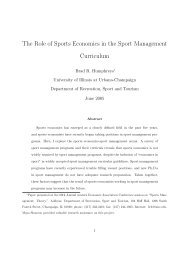You also want an ePaper? Increase the reach of your titles
YUMPU automatically turns print PDFs into web optimized ePapers that Google loves.
Confusing ITF Terminology<br />
For instance, what is known in the greater<br />
martial art community as an axe kick is a<br />
downward kick in ITF <strong>Tae</strong>kwon-<strong>Do</strong>; the<br />
commonly used term roundhouse kick is a<br />
turning kick in ITF <strong>Tae</strong>kwon-<strong>Do</strong>, and so on.<br />
Instead of comparing terminology from<br />
outside of ITF <strong>Tae</strong>kwon-<strong>Do</strong>, in this essay I<br />
will focus chiefly on some confusing<br />
terminology within ITF <strong>Tae</strong>kwon-<strong>Do</strong>. Some<br />
common kicks that are confused include<br />
the crescent kick and inward vertical kick;<br />
the hooking kick, outward vertical kick and<br />
the hook kick; and the reverse turning kick<br />
and reverse hook[ing] kick.<br />
The crescent kick [bandal chagi] and<br />
hooking kick [geolchyeo chagi] are both<br />
defensive techniques in ITF <strong>Tae</strong>kwon-<strong>Do</strong>;<br />
in other words, these kicks are used to<br />
block an opponent's attack. One would use<br />
these blocks for attacks at low or middle<br />
section, but usually not for high section. It<br />
is better to block a high section attack with<br />
your hands / arms than trying to get your<br />
foot up there in time. The motion path for<br />
both these kicks is an arc. The crescent<br />
By Sanko Lewis<br />
Technique names in ITF <strong>Tae</strong>kwon-<strong>Do</strong>, especially of some of the kicks,<br />
can be very confusing. It also doesn't help that the official terms used<br />
in ITF <strong>Tae</strong>kwon-<strong>Do</strong> are often quite different from certain well known<br />
terms that are commonly used in wider martial art circles.<br />
kick arcs inward with the foot cupped and<br />
the foot sole functioning as the blocking<br />
tool. The hooking kick arcs outward<br />
[compare with a palm hooking block] with<br />
the foot sword acting as the blocking tool.<br />
Although the foot sole for the crescent kick<br />
and the foot sword for the hooking kick are<br />
the primary blocking tools, it is possible to<br />
also use other parts of the leg, for instance<br />
the knee to “wave” an attack out of harms<br />
way.<br />
The following points may help to clear up<br />
some confusion with regard to these kicks.<br />
A crescent kick is always done with an<br />
inward arc. There is no such thing as an<br />
outward crescent kick. An “outward<br />
crescent kick” is basically a hooking kick.<br />
Conversely, a hooking kick is always done<br />
with an outward arc. The crescent kick and<br />
hooking kick are only used as defensive<br />
techniques. They are not offensive<br />
techniques. The mix-up comes in because<br />
these kicks are often confused with the<br />
inward and outward vertical kicks.<br />
Vertical kicks are similar to the crescent<br />
<strong>Totally</strong> <strong>Tae</strong> <strong>Kwon</strong> <strong>Do</strong> - 37

















